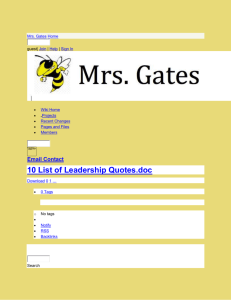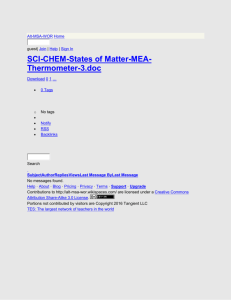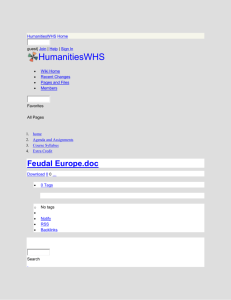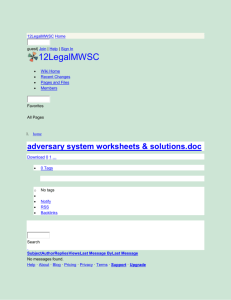D15 Destinations Similarity Based on User Generated Pictures` Tags
advertisement
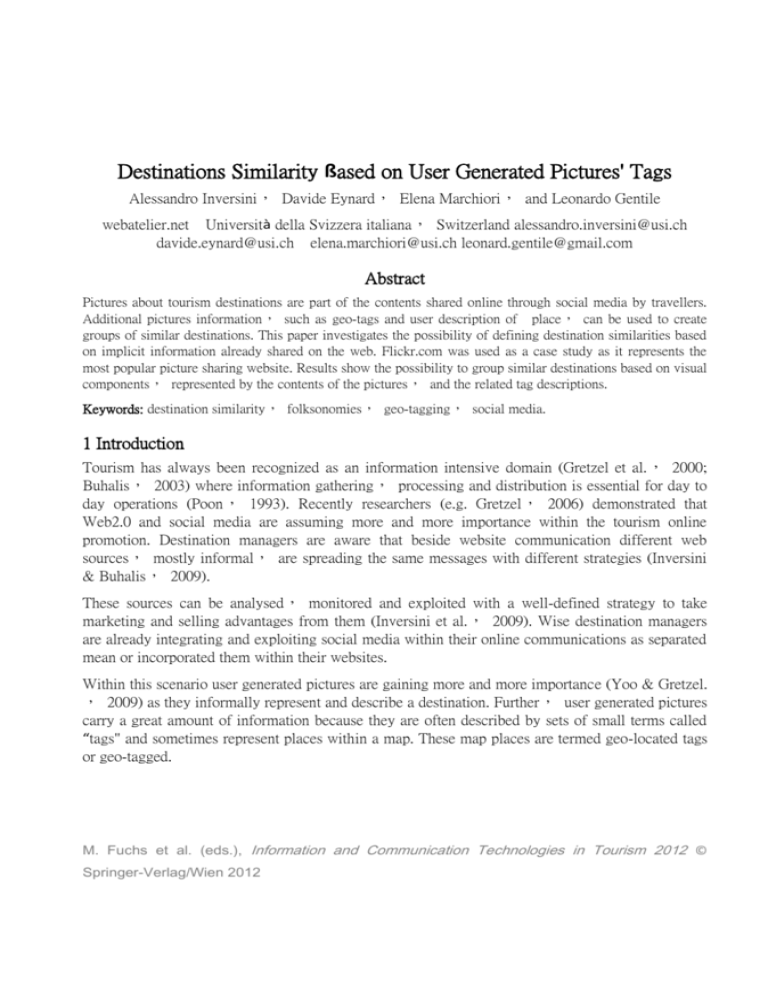
Destinations Similarity ßased on User Generated Pictures' Tags Alessandro Inversini, Davide Eynard, Elena Marchiori, and Leonardo Gentile webatelier.net Università della Svizzera italiana, Switzerland alessandro.inversini@usi.ch davide.eynard@usi.ch elena.marchiori@usi.ch leonard.gentile@gmail.com Abstract Pictures about tourism destinations are part of the contents shared online through social media by travellers. Additional pictures information, such as geo-tags and user description of place, can be used to create groups of similar destinations. This paper investigates the possibility of defining destination similarities based on implicit information already shared on the web. Flickr.com was used as a case study as it represents the most popular picture sharing website. Results show the possibility to group similar destinations based on visual components, represented by the contents of the pictures, and the related tag descriptions. Keywords: destination similarity, folksonomies, geo-tagging, social media. 1 Introduction Tourism has always been recognized as an information intensive domain (Gretzel et al., 2000; Buhalis, 2003) where information gathering, processing and distribution is essential for day to day operations (Poon, 1993). Recently researchers (e.g. Gretzel, 2006) demonstrated that Web2.0 and social media are assuming more and more importance within the tourism online promotion. Destination managers are aware that beside website communication different web sources, mostly informal, are spreading the same messages with different strategies (Inversini & Buhalis, 2009). These sources can be analysed, monitored and exploited with a well-defined strategy to take marketing and selling advantages from them (Inversini et al., 2009). Wise destination managers are already integrating and exploiting social media within their online communications as separated mean or incorporated them within their websites. Within this scenario user generated pictures are gaining more and more importance (Yoo & Gretzel. , 2009) as they informally represent and describe a destination. Further, user generated pictures carry a great amount of information because they are often described by sets of small terms called “tags" and sometimes represent places within a map. These map places are termed geo-located tags or geo-tagged. M. Fuchs et al. (eds.), Information and Communication Technologies in Tourism 2012 © Springer-Verlag/Wien 2012 2 Literature Review 2.1 Tourism Destinations and Technologies The continuous development of Information Communication Technologies (ICT) during the last few decades has had profound implications for the tourism industry asa whole (Buhalis, 2000). The increasing importance of technology has influenced notonly the way transactions and purchase processes (Werthner & Klein, 1999) have evolved, but also the way communication and promotion of tourism goods havedevelop on the internet (Buhalis, 2003). Recently theadvent of, the socalled, Social Media (Blackshaw, 2006) enabled tourists to share information on the internet within the“read/write web", where theend user has become both information consumer, player (Nicholas, et al., 2007) and provider. Marketing managers and researchers are exploiting new ways to adopt social media in the marketing and promotion arenas in order to take advantage of this “electronic word-of-mouth" (Litvin et al., 200�). Recent studies demonstrated that social media contributes to spreading to web information about destinations using different channels and different strategies (Inversini and Buhalis, 2009) as internetusers are in need of communicating their touristic experiences (Inversini & Cantoni, 2009). The web, especially social media, offers a variety of different platforms to share experiences , facts and even rumours (Blackshaw & Nazzaro, 2006). This information published on popular social media is contributing significantly to the massive growthof information on the web, be it relevant for the end user or not. Furthermore, one important role within information spreading by social media is played out by user generated pictures. Following Yoo and Gretzel (2009) one in two tourists view destination photos via UGC in different web communities. The relevance of pictures in travel both to understand culture (Pengiran-Kaha et al., 2010) and to recommend aplace to visit (Linanza et al. , 2011) has also been investigated by recent studies.Contents of pictures shared online can be fragmented into different topics, such asnature , products, and facilities (Govers &Go, 2005). The amount of these experiential-type images can contribute to the online representation of a tourism destination. Pictures shared online can act as a mediated source of information for a prospectiveconsumer, which may influence his/her decision to visit a destination. As in Govers and Go(2005), DMOs can take advantage from online pictures by learning the meanings of pictures shared about a destination and better improve the rich tourism experience that the tourists are looking for.Within social media, user generated travel pictures carry a lot of information. They are often described by sets of small terms called “tags." Once collected the tags build a ����������. Tags, also, often represent places within a map. These are called geo-located tags or geo-tags. 2.2 The �once�t o� �ol�sonomies The term folksonomy was introduced by �ander Wal(200�), by mixing the terms “folk" and “taxonomy". In practice, users assign a set of terms called tags to anindividual piece of content in order to group or classify it for retrieval (Sturtz, 200�). a n The result is informal social network of terms based on users' informal classificationofcontent. The collection of all assigned terms for a piece of content of a single user is called personomy, while the collection of personomies is calledfolksonomy (Hotho et al., 2006). Some examples of successful folksonomies are delicious.com (formerly known del.icio.us), Steve (steve.museum), as and Flickr (flickr.com). In folksonomies user s are not forced to use the same tags; however, users with similar interests tend to converge onto a shared vocabulary with their tags. One of the factors of success for folksonomies is the fact that no specific skills are needed to participate (Hotho et al., 2006). It is therefore possible to argue that folksonomies invite deliberate and idiosyncratic tagging, also called meta noise, which decreases system utility (Wu et al., 2006). For the general purpose of this research folksonomies have been classified into broad and narrow folksonomies: (i) Br�ad �ie emerge in systems whose users can tag any resource, and where aresource can be annotated with many identical tags, one for each user tagging it; in (ii) Narr �� ie where tags are singular in nature for each object and usersare allowed to tag only a limited set of resources, typically the ones they, or theirrestricted circle of friends, have provided. 2.3 Knowledge �rom Geotags Ge�taggi �g is the process of annotating objects and online resources with geospatial contextinformation, ranging from specific point locations to arbitrarily shaped regions. These annotations be explicitly provided by or extracted c a n u s e r s automatically(i.e. byanalyzingw here the user isconnectingfrom, getting GPS data from a mobile device, or extracting geographic metadata from a photo. In onlinephoto sharing communities, user text-based annotation (tags) and location metadata (geotags) often co-exist. Geotag information is typically embedded within picturemetadata (stored in EXIF format , see http://www.exif.org/specifications.html). In this report the term “geotag" refers to the geographic annotations (e.g.where a photo was taken) while “tag" is always intended as the textual annotation related to a photo (e.g. “cat"). Several studies have been conducted on extracting knowledge from Flickr georeferenced metadata. Clements et al. (2010) introduces a method to predict similarlocations, wormholes, based on human travel behaviour. A wormhole is defined as asimilar, but not necessarily spatially close, location on the planet. There are two hypotheses for this: (i) users have specific travel preferences and therefore visit locations that are similar to some extent; and (ii) taking a photo in a specific location is an indication that the user likes that location. From a given target location (L) the algorithm aims to find similar locations around the world. For each user (u), a weight (w) is computed based on the distance of the nearest geo-tagged photo of the user to the target location. Wormholes are then found by aggregating the geotags of all users with Wuas weight per user, and selecting the most relevant positions on Earth according to this metric. ��6 Ahern et al. (2007) show how to analyze tags associated with geo-referenced Flickr images to generate aggregate knowledge in the form of “representative tags" forarbitrary areas of the world. Tags are used to create a visualization tool , “World Explorer" (http://tagmaps.research.yahoo.com/worldexplorer.php), which displays derived tags and original photo items on a world map. Data analysis algorithms are based on multi-level clustering and the scoring of tags is based on TF-IDF (termfrequency, inverse document frequency). A user interface shows, for each map regionand zoom level, the best-scoring tags for the generated clusters; these tags are shown as text over the map area where each cluster occurs. 3 Research Design The aim of this research is to describe destination similarity starting from user generated picture tags from the popular photo sharing social media website Flickr.com. In other words this study tries to define similarities amongst a given number of destinations based on unrestricted user descriptions of the destination itself (i.e. the tags associated to the pictures taken at a specific location). Similarities could be used to compile a destinations recommendations list based on pictures shared on social networks by a given users. Furthermore, the research attempts to understand if additional information related to users (i.e. those who uploaded a given photo) and pictures (i.e. pictures sharing thesame tags) is driving the process of recognizing similar destinations. Given the goal, and the above mentioned literature (i.e. Clements et al., 2010; Ahern et al., 2007) the two main research questions are: RQl: while finding similar destinations thanks totags, does picture-related information matter to provide better results? RQ2: while finding similar destinations, thanks to tags, does users-related information matter to provide better results? In order to pursue this general goal a holistic methodology, based on the related works, has been designed. Research objectives are similar to the ones exposed in Clements et al. (2010), but they are using a TF-IDF approach similar to the one described in Ahern et al. (2007) in order to extract representative tags describing each place. The designed procedure can be summarized as follows: (i) given a dataset of destination-related tags from Flickr a representative description for each city was extracted; then (ii) the similarities between cities were calculated according to thegenerated representations; and finally (iii) an interface was provided that, given a cityas a query term, showed the cities that were more similar according to the previously calculated similarities. The next section describes the research approach of this study. 4 Research A��roach 4.1 A Tag-ßased ity Re� resentation The first step to define similarity between cities was to find an appropriate representation for them. In order to develop the model presented below the “document-term" matrix concept -typically used by document indexing software and search engines- was exploited. According to thisrepresentation , documents areconsidered in terms of the words that appear within them. Similarly, each city was represented as the collection of all the tags assigned to its pictures. For this experiment the tag distribution of Flickr geo-tagged photos belonging to the union of two sets (i.e. the ones related to the top 150 tourism city destinations for the years 2007 and200�, according to “Euromonitor International": http://www.euromonitor.com/Top 150 City Destinations London Leads the Way) was analysed for a total count of 233 cities. Flickr.com easily allows users to get the top tags for a given location (specified as a WOEID) through its flickr.places.tagsForPlace API. However, this API only returnsthe top 100 unique tags , without any information about the photos taken or the users who uploaded them. For this reason , two distinct datasets were built: The former, called T pl00, contains the tags retrieved using the aforementioned API; the latter, called Ra�d, contains a random sampling of photo metadata obtained by querying Flickr APIs with YQL (Yahoo Query Language: an expressive SQL-like languagethat lets developers query, filter, and join data across Web services.) Selecting, for each city, 10 photos from 300 random days, taken at random hours, avoids bias due to day- or time-related events. An important advantage of this second approach is that user-and photo-related information is available, providing new dimensions across which tag analysis can be performed. The resulting collections also contained tags which were not useful or not related to the destinations (e.g. very common terms like day, dog, and friends, or photography-related terms such as canon, nikon, and black&white). So, a blacklist was heuristically created based on the analysis of the top 1000 tags in Flickr.Tags occurring in only one city were also pruned, because in the SM they represent terms that will never match when computing the similarity scores. After cleaning the tag vocabulary the T pl00 and Ra�d��datasets counted, respectively, 23'300 and 55'000 distinct tags.Figure 1 shows the distribution of the top 1,000 keywords. Categories were chosen iteratively during the analysis. �ig. 1. Tag Distribution Top1000 This shows the top 1,000 tag distribution to be: valid tags -�3,9%; geotags - �2, 1%;photography related tags -9%; other tags (dates, Flickr related and non-useful tags) 5%. For the purpose of this study photography related and other tags (dates, Flickr related and non-useful tags) were not considered. 4.2 �alculation o Similarity between �ities The �SM (�ector Space Model) was used to represent cities in terms of their related tags. In the SM each city is represented by a vector in an-dimensional space, where is the number of distinct tags, whose components are weighted according totag frequency. Of course, as tags which are too popular tend to be more widespreadand thus less informative, frequency is normalized using the TF-IDF approach, which normalizes a TF (Term Frequency) with an IDF (Inverse Document Frequency) factor. This takes into account the number of documents containing that term (in ourcase, the number of cities for whose photos a given tag has been used). In the T pl00 dataset the standard IDF has been calculated for normalization: D (1) IDF i;log 2 Di where IDI is the number of destinations used in the analysis (233) and ID iI is the number of destinations containing the tag ti. For the Ra�d�� dataset two more variants of IDF have been calculated, taking advantage of the additional information we were able to gather. The former variant, called IDFP, exploits the extra information coming from the tagged photos: p (2) IDFpi; pi where IPI is the total amount of photos in the Ra�d�� dataset and IPiI is the number of photos tagged with ti. The latter variant, called IDFU, exploits information about the users who have tagged photos about each specific destination: pi U , ii (3) IDFU ii,; p , ii where IPI is the number of photos for the destination j, jIPi,j I is the number of photos for the destination j tagged with ti, IUi,j I is the number of users tagging destination j with the tag ti, and IUjI is the number of distinct users who tagged at least one photo in j. We calculated tag weights for each city by normalizing tag frequencies in four different ways: (SystemA) Top100 dataset, standard IDF; (System B) Randomdataset, standard IDF; (System C) Randomdataset , IDFP , (System D) Randomdataset , IDFU. For each differentnormalization, we then calculated similarities between cities in terms of the cosine distance between their matching vectors: ab土 () similarity(a, b)= cos( ) = 的 ab 4.3 �ront-End Im �lementation The interface was based on an existing open source project , Geoplanet Explorer (http://isithackday.com/geoplanet-explorer/). It was implemented as a PHP Web based application accessing a MySQLdatabase. 4.4 System Evaluation To evaluate the system, an online survey was created in order to ask users which ofthe four similarity measures (i.e. System A -Top100 dataset, standard IDF; System B-Random dataset, standard IDF; System C -Random dataset, IDFP; System D -Randomdataset, IDFU) the best according to them. The survey was w a s o n e composed bya demographic se ctionand a gro up of cities to be evaluated. Users were chosen randomly by posting the survey link on popular social networks. After the demographic section the survey proposed to users clear instructions explaining that the similarities between places are not necessarily geographic and are based on place descriptions (i.e. on harvested information -Figure 2). �ig. 2. Welcome Page and Survey Instructions A small group of cities has been selected for the survey with a high percentage ofEuropean tourism destinations. Additionally a small group of cities from Asia, South America and the USA was inserted in the test. Each user judged one (random) city ata time, for a total of five distinct cities. For each of them the user was provided results of the four scoring systems, in the form of four lists containing the top-five related cities. 5 Results The survey user interface was designed to give basic information about the city (i.e.country, administrative regions, map, etc.), in order to let users easily identify thetested city (in this case Rome, Figure 3). In the front end the sections are clearly defined: (1) information about the place taken from Yahoo! GeoPlanet (http://developer.yahoo.com/geo/geoplanet/), which is used to disambiguate the city from its homonyms (e.g. Rome in Georgia, US); (2) main city pictures from Flickr.com; (3) Map from Yahoo! maps; ( �) the four systems to be rated; (5) the most popular 100 tags from Flickr.com. �ig. 3. Graphic User Interface In section , users could easily understand not only the similarity ranking, but also (tosome extent), the �eee� of similarity thanks to the differing font sizes (the bigger the font the higher the similarity explained on the survey starting page). Since thesimilarity between two places is based on the similarity of their descriptions, users had the possibility to check the tags in common between two cities. This is clearly asimplification, as the adopted similarity metrics were not based on a simple term match. It was considered useful to provide a rough idea of why two cities had been considered similar. 5.1 Evaluation The survey was filled out by 113 users, mostly master students from Università della Svizzera italiana and Politecnico di Milano. Users produced 516 valid answers. The final result (Figure �) yielded a great deal of useful information. �ig. 4. Survey Results The best system according to users is System D (n=139 preferences). System D is based on the weighting scheme in which a greater importance was given to the user factor. System A represents the second most popular answer (n=11� preferences) and it shows that we can extract valuable knowledge gathering information even from the T pl00dataset. In other words , using only the most 100 popular tags for a city andthe classical IDF we can still have good performance, even better than other methods applied to the bigger dataset. The random dataset based on picture information (System C) ranked third accordingto users' preferences in the survey. Finally, system B, differing from A only for thedataset used, ranked last in users' preferences. “N" represents the “no answer" group (n=�). Returning to the above mentioned research questions, it is thus possible to claim that (RQ2) the additional information coming from user tagging activities (i.e. who tagged a photo with a given tag) is much more relevant , while defining thesimilarity of two places or destinations , than (RQ1) picture-related information (i.e. which pictures have been tagged with a given tag). 6 Discussion and �onclusion Surprisingly System A, relying on the much more limited T� pl00dataset, ranked better than other two systems (i.e. Systems B and C) that were using an extended sample based on the random harvesting of picture tags obtained with Yahoo Query Language. This means that the top 100 tags Flickr.com allows to be downloaded with its API are representative enough of the destinations and can be used to compare themwith discrete results. Furthermore, the relevance of user-related information seems to be a driver to define similar cities/destinations. This confirms the validity of other approaches (such as the “Wormholes" one) and provides useful insight for the development of new tag-and user-based a recommender systems. Actually, with the current model and technology this system is already able to suggest and/or recommend to users, which own a collection of picturesof a given place/destination in a popular social network such as Flickr.com, to visit other places/destinations without asking them any additional information about their preferences. 7 Limitations and uture Wor� Limitation includes three issues. First, it was assumed that random sample was moreprecise in shaping destination similarity, but from the results of this research it does not seem to provide more information. Its real advantage, instead, is the additional information about users and photos that can be exploited to provide a better similaritymeasure. Second, demographic data was asked within the survey but not used in thefinal evaluation due to a shortfall of the system. Finally , as the current research was a starting point for a more in-depth research a light evaluation methodology with a snowball sampling was used. Future work will cover these limitations. It will study, in depth, the difference between top 100 samples and random samples using both the case information about users and information about pictures to define if these preliminary findings can be confirmed. The demographic data will be added within the evaluation phase to try and leverage users' travel preferences and history. Finally a better sampling methodology will be used. Re� erences Ahern, S., Eckles, D., Good, NS. & King, S. (2007). Over-exposed?: privacy patterns andconsiderations in online and mobile photo sharing. In Hu a� Fact�r i� C puti�g S� te . Blackshaw, P. ( 2006). The c u er-ge� erated ureei a ce cuture. Retrieved October 13,200�, from http://www.clickz.com/showPage.html?page=3576076. Blackshaw, P. & Nazzaro, M. (2006). C u� er-ge �erated edia (cg ) l0l: W �rd-��- �uth i� the age the �eb-rti ied c u� er. Retrieved August, 1 , 2007.Buhalis, D. (2000). Marketing the competitive destination of the future, T�uri Ma�age et 21(1): 97-116. Buhalis, D. (2003). eT�uri��: I r�ati tech� g r �trategic t�uri�� �a�age �e�t. Harlow: Prentice Hall. Clements, M., Serdyukov, P. & Deries, A. (2010). Finding Wormholes with Flickr Geotags Adea�ce i� I r ati 5993: 65�-661. Govers, R. & Go, F. (2005). Projected Destination Image Online: Website Content Analysis of Pictures and Text. I ���r ati Tech��� �g� a�d T �uri 7: 73-�9. Gretzel, U. (2006). Consumer generated content -trends and implications for branding. eReeie� T uri Re �earch (3): 9-11. Gretzel, U., Fesenmaier, D. R. & O'Leary, J. T. (2006). The transformation of consumerbehaviour. In Buhalis, D. and Costa, C. (Eds.), T�uri Bu�i�e Fr ��tier . Oxford: Butterworth-Heinemann. Gretzel, U.,Yu-Lan, Y. & Fesenmaier, D. (2000). Preparing for the New Economy: Advertising Strategies and Change in Destination Marketing Organizations. J �ur a Traee Re earch 39(2): 1� 6-156. Hotho,A., Jaschke,R., Schmitz, C. &Stumme, G. (2006). Information retrieval in folksonomies: Search and ranking. In pr ceedi g the 3rd Eur pea� Se�a� tic Web C� ere� ce, Lecture Notes in Computer Science. Springer. Inversini, A. & Buhalis, D. (2009). Information Convergence in the Long Tail. The Case of Tourism Destination Information. In W.Hopken, U. Gretzel and R. Law(Eds.), I ��r ati� a dC u �icati Tech�� gie i T� uri 2009 -Proceedings of theInternational Conference in Amsterdam, Netherland (pp. 3 �1-392). Wien: Springer. Inversini, A., Cantoni, L. & Buhalis, D. (2009). Destinations' Information Competition and Web Reputation. Jura I �r ati�� Tech �g� &T�uri 11: 221-23� . Inversini, A. & Cantoni, L. (2009). Cultural Destination Usability: The Case of isit Bath. In W. Hopken, U. Gretzel and R. Law (Eds.), I ��r ati� a�d C u�icati Tech��� �gie i� T �uri 2009 -Proceedings of the International Conference inAmsterdam, Netherland (pp. 319-331). Wien: Springer. Linaza, A., Agirregoikoa, A. Garcia, Torres, J. & Aranburu, K. (2011 ) Image-based Travel Recommender System for small tourist destinations. In R. Law, M Fuchs, F. Ricci(Eds.), I ��r ati� a �d C u icati� Tech gie i T� uri 20ll -Proceedings of the International Conference in Innsbruck, Austria (pp. 1-12). Wien: Springer. Litvin, S. W., Goldsmith, R. E. & Pan, B. (200 �). Electronic word-of-mouth in hospitality and tourism management. T�uri Ma�age e�t 29: 5�-�6 �. Nicholas, D., Huntington, P., Jamali, H.J. & Dobrowolski, T. (2007). Characterizing and evaluating information seeking behavior in digital environment: spotlight on the bouncer. I ��r ati�� pr�ce i�g a�d Ma�age et �3( �): 10 �5-1102. Pengiran-Kahar, D.I.N.F., Syed-Ahmad, S.F., Ismail S.H.S. & Murphy, J.(2010). Shared Arabian Muslim Travel PhotosIn Gretzel, U., R. Law, M Fuchs (Eds.), I� r�ati a�d C u�icati� Tech gie i T�uri 20l0 -Proceedings of the InternationalConference in Lugano, Switzerland. Wien: Springer, 591-603. Poon, A. (1993). T uri �� Tech� g a� d C� �petitiee Strategie� . Wallingford, CT: CABInternational, Oxford. Sturtz, D.N. (200�). C u a Categ�ri�ati� �: the F . INFO622: ContentRepresentation, December.�ander Wal, T. (200�). ��u d� �ith F � -Reteived March 2�, 200�, from http://www.vanderwal.net/random/entrysel.php?blog=1529 Werthner, H. & Klein, S. (1999). I r ati Tech �g� adT�uri � A Cha ��e�gi�g Re �ati� ��hip. Wien -New York: Springer �erlag. Wu, H.�ubair, M. & Kurt, M. (2006). Haree�ti� g cia ��edge r� F �ie� . Odense, Denmark: HT. Yoo, K.H. & Gretzel, U. (2009). Trust in travel-related consumer generated media. In W.H�pken, U. Gretzel and R. Law (Eds.), I ��r ati a� d C u icati� Tech gie i� T �uri, Wien: Springer, �9-59.
